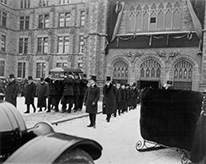- Home>
- About Us>
- History and Buildings>
- Parliament Moves In
© National Archives of Canada; Martin Lipman © Canadian Museum of Nature
Close.Parliament Moves In
A new home for Parliament
Nature Scoop
After Parliament burned on Feb. 3, 1916, the Museum housed the House of Commons and the Senate for 4 years.
Musée Bytown Museum © Public domain
The charred shell of Centre Block on February 4, 1916, the morning after the fire.
Library and Archives Canada PA22433 © Public domain
Opening of a session of the House of Commons in the museum's theatre in 1918. Prime Minister Robert Borden is seated at the desk on the left near the Speaker. Sir Wilfrid Laurier is at the desk on the right.
Library and Archives Canada C1973 © Public domain
Sir Wilfrid Laurier addressing members of the House of Commons in the museum's theatre circa 1916.
Library and Archives Canada C7213 © Public domain
The funeral procession of Sir Wilfrid Laurier leaving the museum.
The fire that consumed most of Canada's Parliament Buildings on February 3, 1916, would have a dramatic effect on the course of the museum for four years.
The fire was believed to have started from a smouldering cigar in the House of Commons Reading Room. It destroyed the Centre Block and caused the tower to crumble. Seven people died in the catastrophe. (Read more about the fire).
Despite the devastation, the business of Parliament needed to continue. Canada was in the midst of the First World War. The best solution for a temporary site lay one mile due south—at our museum, which had just opened in 1912 as Canada's first national museum.
The morning after the fire, the theatre of the museum was converted into a temporary Commons Chamber. It included a gallery for visitors and the press. That afternoon, the House of Commons sat and conducted business as usual. Prime Minister Sir Robert Borden acknowledged condolences for the devastation of the fire and the loss of seven lives.
Parliament stayed in the museum for four years.
A Museum Moves Out
To accommodate the business of Canada's legislators, galleries were closed to the public, and specimens and artifacts were moved to side walls. Scientists and curators relocated to offices outside the museum; some retained offices and labs in the museum basement. It was quite a commotion!
The Senate of Canada also moved into the mineral gallery on the first floor. That this room had formerly held the Invertebrate Fossils gallery was a source of amusement at the time.
Legislation within the Museum's Walls
Borden's ruling Conservatives debated many initiatives with the opposition Liberals, led by Sir Wilfrid Laurier. Important laws were passed in the museum over the four years. One such law was the Military Service Act, 1917, which instituted a war-time draft to recruit Canadian soldiers. Also in 1917, the law that introduced income tax was passed, originally intended as a temporary war measure.
On May 24, 1918, Parliament passed within the museum's walls An Act to confer the Electoral Franchise upon Women, which recognized the right of Canadian women to vote in national elections.
Laurier Dies
On February 17, 1919, Canada lost one of its most famous politicians and orators, Sir Wilfrid Laurier. Laurier was Prime Minister from 1896 to 1911. He had been serving as Leader of the Opposition from 1911 until his death.
The renewed Parliament was still under construction, so he was lain in state in the theatre of the museum. An estimated 50 000 Canadians came to pay their final respects.
Browser Plug-Ins
In order to fully access some of the content on this page, you may need to download the following:








